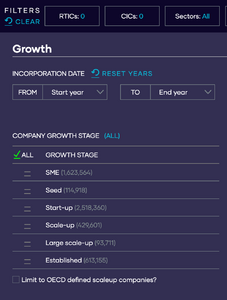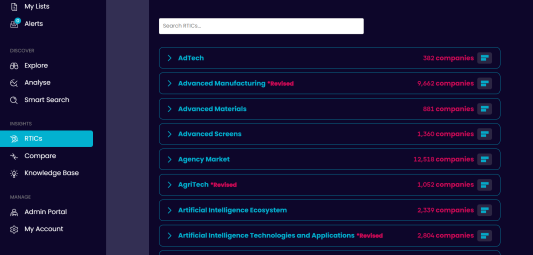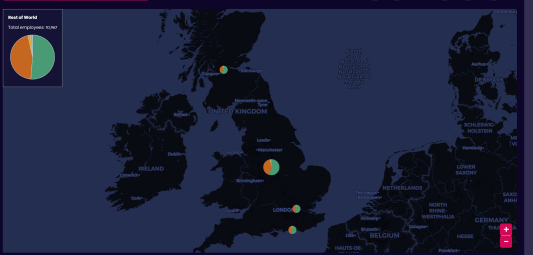Back in November 2022, in v4.2, we released our first version of our company growth stage estimates. Our original growth stage definitions are based on those from Scottish Enterprise. We have adapted these definitions to align with the data available on our platform.
When we released these categorisations (I’m careful not to use classifications here!), we wrote a blog post about them.
We revised the growth stages in v4.3. Fixed some bugs in v4.5. We fixed companies that “had fallen off the growth track” and labelled them as SME in v.4.7. Added the OECD’s definition of scale-ups in v4.8 and applied some fixes in v4.9. We’ve just released 4.11.
As of 07/11/2023, this is how the growth stage filter currently looks:

As you can see, it’s quite confusing. Currently, we have three definitions of what a scale-up is. We wanted to fix this and have one.
The change
Firstly, we’ve made changes to our existing definition. We’re moving away from “growth stages” and towards “company sizes”, as well as standardising our scale-up definition.
This reflects what we’re representing more accurately. Our new company size categories are:
| Company Size | Annual Turnover (£) | Number of Employees |
|---|---|---|
| Micro | Less than 632k | Less than 10 (minimum of 1) |
| Small | Less than 10.2m | Less than 50 |
| Medium | Less than 36m | Less than 250 |
| Large | More than 36m | More than 250 |
Our company sizes are based on the UK’s legislation definition on company sizes. We also have a category for no employees or turnover.
A given company must meet both conditions to be categorised accordingly. If a company meets only one condition, its company size categorisation will only increase when it meets both.
Scale-up filter
Since our discussions with the scale-up institute and since we changed our Cities filter to reflect the OECD’s definition of urban areas, we’ve decided we want to shape our scale-up filter around the OECD’s definition of a scale-up.
The definition of an OECD scale-up company is extremely close to what we’ve implemented on the platform. This is the OECD definition (source):
“All enterprises with average annualised growth greater than 20% per annum, over a three-year period should be considered as high-growth enterprises. Growth can be measured by the number of employees or by turnover.”
With this new definition, a company must:
- Have had at least 10 employees (this could be an estimate) in at least one point in time.
- Have a growth rate which exceeds 20%. This is their average annual growth rate.
You can read more about our estimates and average annual growth rates here.
Our growth rate metric adheres to the OECD’s definition, as it necessitates a minimum of three years of data on reported employees or turnover (TO) from annual accounts.
Our estimates and average annual growth rates are used in both the company size definitions and in the scale-up filter. The scale-up filter is located within the growth tab:

Using the OECD’s definition to determine a company’s growth stage enhances the ease of making global comparisons. We’ve removed start-up as the OECD does not provide a definition for a start-up.
We appreciate there are many different definitions of company size and company growth stages, and which one is right for you will depend on the purpose of your analysis.
Our platform still allows for custom definitions using the filters bar, particularly within the financial tab:

To recap, we’ve moved away from growth stages to company sizes and implemented the OECD’s definition of scale-ups. If you would like any extra information or would like to offer feedback, please get in touch.


